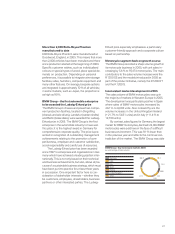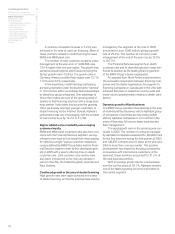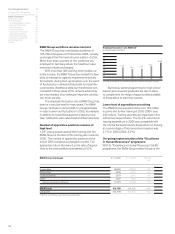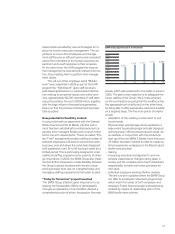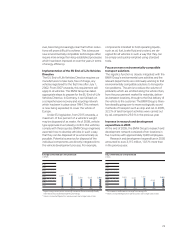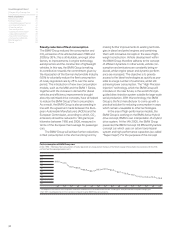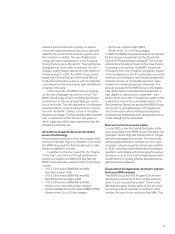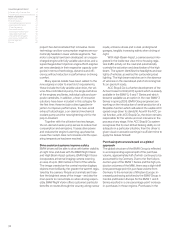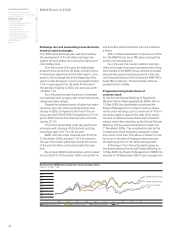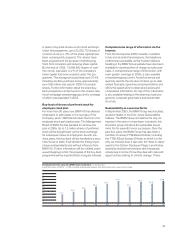BMW 2005 Annual Report Download - page 32
Download and view the complete annual report
Please find page 32 of the 2005 BMW annual report below. You can navigate through the pages in the report by either clicking on the pages listed below, or by using the keyword search tool below to find specific information within the annual report.31
vehicle’s active transmission system, an electric
motor with high performance electronics has been
added to the conventional automatic gearbox and
the converter is omitted. The use of hybrid tech-
nology will reduce consumption in the European
Driving Cycle by up to 20 percent.The main feature
distinguishing it from other solutions is the use
of space-saving Super Caps as the main means of
storing energy. In 2005, the BMW Group joined
forces with DaimlerChrysler and General Motors
to develop hybrid drive systems with the objective
of pooling know-how and making rapid and efficient
progress in this area.
In the long-term, the BMW Group is working
on the use of hydrogen as a source of fuel. The
BMW CleanEnergy Initiative confirms the Group’s
commitment to the use of liquid hydrogen as the
fuel of the future. The sixth generation of a hydrogen
powered vehicle, currently being tested in conjunc-
tion with the BMW 7 Series, is now at the series
development stage. The first vehicles will be handed
over to customers within the next two years, at
which stage they will be able to prove that they are
suitable for everyday use.
Abundance of awards demonstrate lead in
terms of technology
At the International Engine of the Year Awards 2005,
the most important engine competition in the world,
the BMW Group was the first manufacturer to take
home six trophies in one year.
In addition to the main award for the “Engine
of the Year”, won by the V10 high performance
engine that powers the BMW M5 and M6, the
BMW Group was also presented with the following
awards:
– V10-5.0 litre motor (BMW M5 and M6):
Best New Engine 2005
– V10-5.0 litre motor (BMW M5 and M6):
Best Performance Engine 2005
– V10-5.0 litre motor (BMW M5 and M6):
Winner in the 4 litre plus engine category
– 3.0 litre VariableTwinTurbo-Diesel (BMW 535d):
Winner in the 2.5 to 3.0 litre category
– 3.2 litre six-cylinder engine (M3):
Winner in the 3.0 to 4.0 litre category
In 2005, the BMW Group was praised for its success-
ful technology management by the Fraunhofer-
Institut für Produktionstechnologie (IPT) in its Inter-
national Benchmarking Project on Success Factors.
According to the Institute, the BMW Group is one
of Europe’s five most innovative companies. As part
of an investigation by the IPT, particularly successful
methods and concepts in technology management,
otherwise known as “successful practices”, were
singled out in leading European companies. The
basis of success for the BMW Group is the strategi-
cally-driven desire to develop technologies with a
high degree of usefulness for customers – com-
bined with an innovation management system which
is second to none in the automobile industry. The
Benchmarking Project jury praised the BMW Group
not only for its groundbreaking technologies, but
also for the way in which professional innovative
processes are embedded, both strategically and cul-
turally, throughout the enterprise.
New test centre for passive safety
In June 2005, a new test centre for passive safety
was inaugurated at the BMW Group’s Research and
Innovation Centre (FIZ) and has become an integral
part of the development process. This technically
well-equipped installation is linked up to the crash
simulation catapult equipment which was installed
in 2000; it provides experimental data and analysis
results for automobiles and motorcycles for various
purposes, such as ensuring that legal requirements
are adhered to or testing whether development tar-
gets have been achieved.
Cooperation arrangements relating to engines
for future MINI versions
The BMW Group and PSA Peugeot Citroën have
developed a new family of four-cylinder petrol en-
gines in a joint cooperation project. These newly
developed engines employ state-of-the-art motor
technology and are intended, as well as for other
vehicles, for use in future versions of the MINI. This


